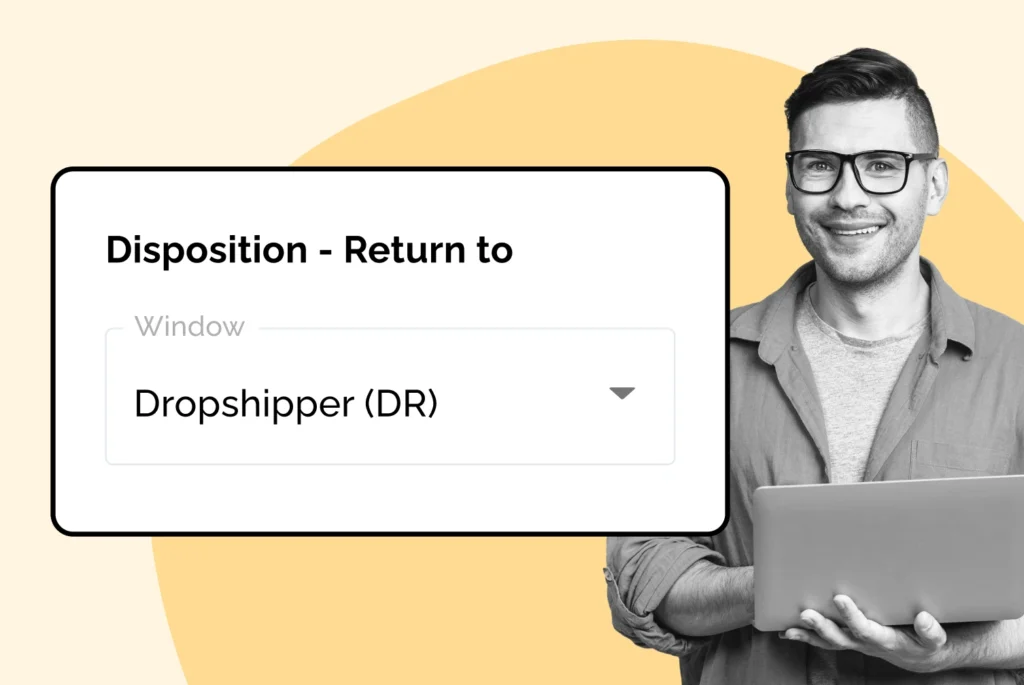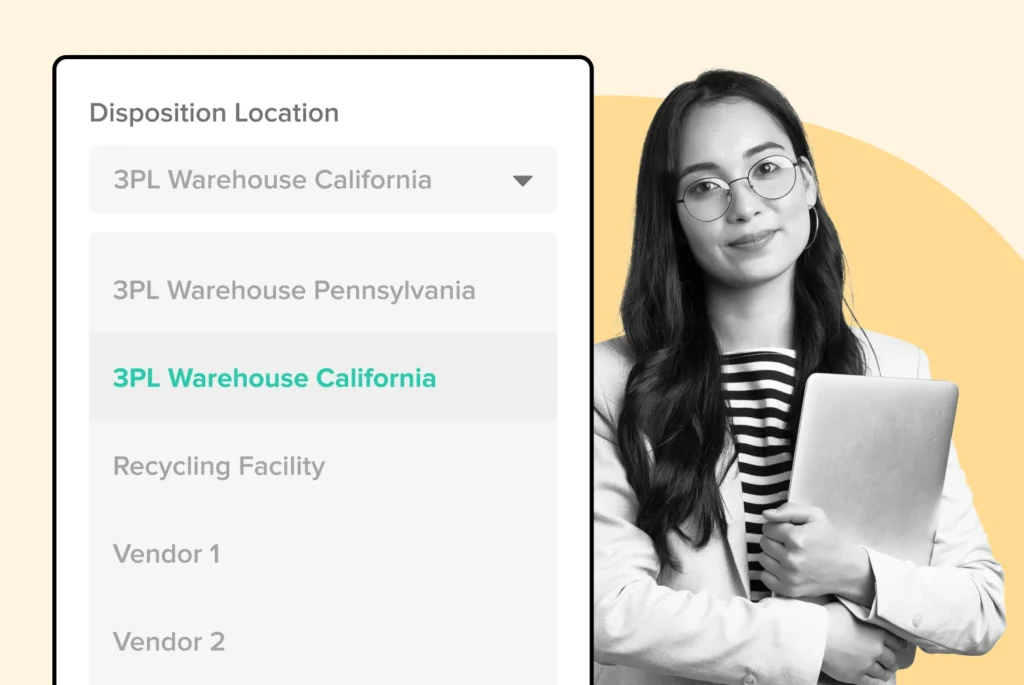
Strategies to Optimize Sales and Return Process for Swimwear Season
This article will show you how to optimize the sales and return process for swimwear, boosting customer satisfaction and revenue!
Shipping, Tracking & Notifications
Boost customer experience and reduce support tickets
Realtime order and shipment tracking
Proactive order and shipping notifications
AI-Enhanced Discounted Labels
Predictive pre-purchase estimated delivery dates
Self-Serivce branded order tracking
Effortless experience delivered
Identify and Resolve Order Issues
Realtime order and shipment tracking
Make returns profitable and delight customers
Flexibility to define any return destinations & conditions
Simplify returns for your customers and team
Incentivize exchanges over returns
Returns management made easy for your team
Returns management made easy for your team
Easy claims and smart upsells
Understand why your customers are returning
In-Store & Curbside Pickup
Unify the online and the in-store experience
Hassle-free pickup experience for customers
In-Store dashboard to keep operations streamlined
In-Store and Online orders unified
Drive foot-traffic to your stores
Shipping, Tracking & Notifications
Boost customer experience and reduce support tickets
Realtime order and shipment tracking
Proactive order and shipping notifications
AI-Enhanced Discounted Labels
Predictive pre-purchase estimated delivery dates
Self-Serivce branded order tracking
Effortless experience delivered
Identify and Resolve Order Issues
Realtime order and shipment tracking
Make returns profitable and delight customers
Flexibility to define any return destinations & conditions
Simplify returns for your customers and team
Incentivize exchanges over returns
Returns management made easy for your team
Returns management made easy for your team
Understand why your customers are returning
In-Store & Curbside Pickup
Unify the online and the in-store experience
Hassle-free pickup experience for customers
In-Store Dashboard to keep operations streamlined
In-Store and Online orders unified
Drive foot-traffic to your stores
Boost customer experience and reduce support tickets
Realtime order and shipment tracking
Proactive order and shipping notifications
AI-Enhanced Discounted Labels
Predictive pre-purchase estimated delivery dates
Self-Serivce branded order tracking
Effortless experience delivered
Make returns profitable and delight customers
Flexibility to define any return destinations & conditions
Simplify returns for your customers and team
Incentivize exchanges over returns
Returns management made easy for your team
Equip your team for precise return checks.
Easy claims and smart upsells
Understand why your customers are returning
Unify the online and the in-store experience
Hassle-free pickup experience for customers
In-Store Dashboard to keep operations streamlined
In-Store and Online orders unified
Drive foot-traffic to your stores
Find the answer to all your questions
Take a step by step trip through our functionality to see how we can improve your ecommerce processes.
Explore the most comon questions about WeSupply
Calculate the ROI that WeSupply can bring you
Read actionable articles on how to optimize your post-purchase experience and decrease support tickets
Get inspired by stories of how our customers implemented an effortless post-purchase experience
Wondering if WeSupply is a good fit for you? Read through our use cases to see how we can help you increase conversion & improve CX!
A Deep Dive into Top Companies' Order Tracking & Returns Strategy
Find the answer to all your questions
Explore the most comon questions about WeSupply
Calculate the ROI that WeSupply can bring you
Request a no strings attached review of your current shopping experience and missed conversion opportunities
Take a step by step trip through our functionality to see how we can improve your ecommerce processes.
Read actionable articles on how to optimize your post-purchase experience and decrease support tickets
Get inspired by stories of how our customers implemented an effortless post-purchase experience
A Deep Dive into Top Companies' Order Tracking & Returns Strategy
Wondering if WeSupply is a good fit for you? Read through our use cases to see how we can help you increase conversion & improve CX!

Sustainable returns are crucial for reducing waste and promoting eco-friendly practices in eCommerce. In this article, we will explore strategies like carbon offsetting, bulk shipping, and returnless refunds to achieve sustainable performance. Adopting these methods can help your brand minimize environmental impact and improve customer satisfaction.
Implementing sustainable returns practices, such as returnless refunds and eco-friendly shipping methods, is crucial for eCommerce brands to reduce environmental impact and foster customer loyalty.
Using technology and data analytics, like returns management systems (RMS) and returns data tracking, can streamline returns processes and provide insights to improve sustainability and efficiency.
Communicating a transparent and informative return policy that highlights a company’s commitment to sustainability helps build trust with eco-conscious consumers and differentiates the brand in the market.
Adopting a sustainable business model that integrates eco-friendly practices into every aspect of the returns process.
WeSupply streamlines returns with Returnless Refunds, in-store and curbside options, pre-printed labels, and Intelligent Disposition. It helps to provide detailed product descriptions, clear return policies, and robust analytics to enhance sustainability and customer satisfaction. Get started with WeSupply for a seamless, eco-friendly returns process.
The shift towards sustainability in eCommerce is driven by a growing awareness of the environmental impact of our consumption habits. As consumers become more eco-conscious, their expectations for brands to practice environmental friendliness at every stage of a product’s journey also increase. This shift is not just a trend but a fundamental change in consumer behavior, demanding effective corporate stewardship and sustainable performance from businesses.
Ecommerce returns, a critical aspect of the customer experience, generate billions of pounds of landfill waste and significant carbon emissions. Ignoring sustainability in returns can harm a retailer’s brand image and push customers away, making it imperative for businesses to adopt sustainable returns practices. These practices not only reduce waste but also foster stronger customer relationships and drive repeat purchases.
Sustainable returns are crucial for reducing the environmental impact associated with transportation, packaging waste, and energy consumption. Consumers are increasingly seeking out stores with sustainable practices, with 78% indicating that a business’s environmental practices influence their buying decisions. By implementing sustainable returns, businesses can build trust with eco-conscious consumers and set themselves apart from competitors.
Sustainability means balancing present needs without compromising future generations’ ability to meet theirs, ensuring sustainable performance. Reducing packaging waste is critical in eCommerce, as excessive packaging contributes significantly to environmental degradation. Sustainable returns practices can help decrease waste and lead to cost savings, such as reusable packaging materials.
By adopting these practices, businesses can minimize the strain on landfills and natural resources while enhancing their brand image and customer loyalty.
Consumer demand for eco-friendly practices in eCommerce is on the rise. Approximately 73% of shoppers are likely to change their consumption habits to reduce environmental impact. Retailers like H&M and IKEA offer incentives for customers to return items for resale or recycling, contributing to a sustainable business model.
This trend is not only beneficial for the environment but also aligns with the values of 70% of consumers who favor brands that prioritize sustainability and are willing to pay a premium for sustainable products.
Implementing sustainable returns strategies is essential for brands pursuing similar sustainability objectives and achieving sustainable performance. WeSupply offers innovative solutions such as Returns Analytics and intelligent dispositions to streamline the returns process and make it more sustainable.
These strategies include:
Offsetting carbon emissions
Bulk shipping
Returnless refunds
Encouraging in-store returns
Adopting eco-friendly shipping methods
Each strategy, including the company’s existing strategy, plays a crucial role in reducing the environmental impact of eCommerce returns.
Offsetting carbon emissions through renewable energy projects is a powerful way to mitigate the environmental impact of returns. Renewable energy projects, such as wind, solar, and hydroelectric, help shift from fossil fuel-based energy to more sustainable forms of energy production. These projects can be categorized into removal projects, like reforestation, and avoidance projects, such as renewable energy initiatives. By supporting America’s clean energy sector, we can further contribute to the global transition towards a greener future.
By investing in high-quality carbon offsets verified by standards like the Gold Standard, businesses can ensure the credibility and effectiveness of their sustainability efforts.
Bulk shipping is another effective strategy to reduce transportation emissions and overall environmental impact. Here are some ways to implement this strategy:
Consolidate return shipments to significantly lower carbon emissions by reducing the number of individual shipments.
Encourage bulk purchases to minimize travel distances and reduce fuel consumption.
Optimize route efficiency with advanced routing software to further reduce travel distances and fuel consumption.
By implementing these strategies, you can make a positive impact on the environment.
Partnering with green logistics providers and positioning products closer to the customer base through local warehousing are also effective ways to lower emissions.
WeSupply’s Returnless Refunds solution is designed to streamline the return process for low-value or damaged items, enhancing customer satisfaction while promoting sustainability.
Key Features:
Green Returns: Allow customers to keep low-cost items when requesting a return, saving on shipping costs and increasing customer satisfaction by providing quick refunds or exchanges. This also helps prevent items from ending up in landfills.
Damaged Items: Direct damaged products to recycling or repair facilities, supporting environmental responsibility and sustainable practices.
Create custom return policies
There are many moving pieces in ecommerce logistics. Book a quick call with our experts to see how WeSupply can help you take control by creating custom policies to handle them all easily. You get to decide how you want to handle final sale items, return window lengths, return request approvals, and more.
Encouraging in-store returns can help reduce shipping-related environmental impact. In-store returns offer the following benefits:
Cut down on return shipping emissions
Transform potential losses into improvements in customer satisfaction and sustainability
Customers returning items in-store often bring back the original packaging, reducing additional packaging waste.
Moreover, managing returns in-store can reduce return fraud and allow retailers to leverage data from in-store returns to collaborate with manufacturers for product improvements.
WeSupply’s solution for encouraging in-store returns is designed to minimize shipping costs and enhance the overall customer experience. By offering options for in-store or curbside returns, similar to services provided by Target, Walmart, Nordstrom, and DSW, retailers can benefit from several key advantages.
Key Features:
Instant refunds: Provide immediate refunds, enhancing customer satisfaction and loyalty.
Adopting eco-friendly shipping methods, including the use of biodegradable materials, contributes to a more sustainable returns process. Eco-friendly shipping includes using biodegradable materials, consolidating orders into single shipments, and using low carbon-emitting transportation methods. Additionally, distributing inventory to multiple regions reduces transit routes and overall transportation emissions.
Encouraging customers to reuse and recycle packaging further helps reduce environmental impact.
Key components of a sustainable returns process include pre-printed return labels and efficient reverse logistics. These components help reduce transportation emissions and improve resource efficiency.
Utilizing digital solutions for return management also minimizes physical paperwork and enhances overall sustainability.
WeSupply’s Pre-Printed Return Labels feature simplifies the return process, making it convenient for both customers and staff. By enabling automatic generation of return labels and offering printerless return options, WeSupply ensures a seamless return experience.
Key Features:
Printerless Returns via QR Code: Enhance customer experience by allowing returns without the need for a printer. Customers receive their shipping label as a QR code and can drop off their returns at eligible FedEx Office, Walgreens locations for FedEx returns, and United States Post Offices for USPS returns.
Reverse logistics play a crucial role in managing returned items and supporting a circular economy. This systematic process involves:
Recycling and repurposing returned items
Supporting a circular economy
Optimizing the cost and time taken to process returns
Enhancing overall supply chain efficiency.
Partnering with third-party logistics providers can further improve reverse logistics capabilities and offer specialized services.
WeSupply’s Reverse Logistics solution leverages Intelligent Disposition to optimize the return process for e-commerce businesses. By directing returned products to the most appropriate locations, WeSupply enhances efficiency, reduces costs, and promotes sustainability.
Key Features:
Optimized Product Routing: Directs items to the nearest suitable warehouse, recycling facility, donation center, or outlet store based on specific criteria.
Reduced Processing Time and Costs: Minimizes the need for a centralized return location, speeding up the return process and cutting costs.
Improved Sustainability: Reduces waste by ensuring items are processed in the most environmentally friendly manner.
Enhanced Customer Satisfaction: Provides faster refunds by streamlining the return process.
Reducing return rates based on customer feedback is essential for a more sustainable process. Detailed product descriptions, customer feedback, and size charts are key strategies to achieve this goal. Retail returns in 2022 amounted to more than $800 billion in lost sales, significantly impacting both the environment and retailers.
By reducing return rates, businesses can decrease pollution, greenhouse gas emissions, and the number of items ending up in landfills.
WeSupply enhances the shopping experience by providing detailed product descriptions and clear return policies, supported by robust analytics and flexible return rules. This approach helps businesses improve their product offerings and streamline return processes.
Key Features:
Returns Analytics: Gain insights at the SKU level to quickly identify return reasons for each product and variant, including color, quality, and size.
Adjust Sizing Charts: Refine based on specific product feedback.
Review Product Images: Ensure accuracy and appeal.
Identify Review Needs: Highlight products that require more reviews.
Customer Feedback: Gather insights on product fit and performance.
Flexible Returns Rules: Tailor return policies to match any use case, avoiding restrictive policies.
Smart Return Rules: Match return conditions to specific item attributes.
Customizable Conditions: Offer perks like free return shipping with flexible return logic.
Intelligent Dispositions: Efficiently sort physical returns for optimal processing.
WeSupply empowers businesses to collect and act on customer feedback through advanced logistics analytics, ensuring continuous improvement and customer satisfaction.
Key Features:
Leveraging data for better business decisions involves data-driven decision-making by tracking and analyzing returns data for continuous improvement. Data-driven decision-making helps businesses maintain a competitive edge by transforming raw data into actionable insights.
Customer segmentation and personalization allow businesses to tailor marketing efforts to meet specific needs, improving customer satisfaction and loyalty.
Analyzing returns data can help identify areas for improvement and reduce return rates. Tracking returns data reveals common issues in the customer journey, allowing businesses to address pain points and improve the shopping experience. Analyzing return reasons and patterns offers valuable feedback about product quality, sizing issues, and areas for improvement.
Leveraging this data can enhance customer satisfaction by addressing common return reasons and improving product descriptions.
WeSupply’s Returns Analytics provides eCommerce businesses with the tools to track and analyze returns data for continuous improvement. By understanding the reasons behind returns, businesses can make informed decisions to enhance their product offerings and customer satisfaction.
Key Features:
Understand Return Reasons: Gain insights into why specific products are being returned.
Reduce Return Rate: Use actionable insights to lower return rates.
BigQuery Integration: Access and analyze returns data in BigQuery for advanced insights.
SKU Level Analysis: Quickly identify return reasons by product and variant, including color, quality, and size.
WeSupply dramatically enhances your return on investment (ROI) by streamlining the customer journey, reducing operational costs, and boosting customer satisfaction. Our platform automates critical processes, provides real-time insights, and personalizes the customer experience, ensuring you get the most out of every dollar spent. Ready to see how WeSupply can transform your ROI? Try our ROI Calculator today and discover the potential savings and revenue growth for your business!
Returns Analytics for eCommerce Business
Book a quick call with our experts to see how WeSupply can help you: Understand why your customers are returning; Identify the most returned products; Understand why those products are returned; Identify which customers are serial returners; Reduce Return Rate with Actionable Insights; Returns data available in BigQuery.
In 2020, COVID-19 dramatically increased e-commerce sales, with a corresponding spike in return rates—up to 50% in some apparel industries. EVEREVE faced significant challenges in managing returns, which were highly manual and lacked visibility. This inefficiency led to problems like delayed returns, markdowns, and overwhelmed customer service.
To address these issues, EVEREVE leveraged WeSupply’s technology, integrating with systems like Magento, Zendesk, and Veeqo to automate and streamline the returns process. This transformation focused on three key objectives: proactivity, self-service, and return flexibility. The results included cost savings, faster and more accurate returns, and a seamless customer experience. By using predictive analytics and automation, EVEREVE turned returns into opportunities, enhancing both operational efficiency and customer loyalty.
Returns management systems play a significant role in sustainable returns, with RMS streamlining the process and reducing waste. Platforms like ReturnGO offer an open post-purchase solution that maximizes revenue and minimizes waste in the return process.
Technological platforms integrate with various eCommerce systems to streamline returns and provide valuable data insights.
Returns management systems can help businesses efficiently manage returns and minimize waste. An RMS automates and streamlines the returns process, facilitating easier management of returns for both businesses and customers. These systems provide valuable data insights on returns trends and reasons, aiding in inventory management and customer service decisions.
Integrating an RMS with other eCommerce systems can enhance the overall customer experience.
Streamlining the returns process with RMS can lead to a more sustainable and efficient system. An RMS like WeSupply provides data on returns that can aid in improving the returns process and making data-driven decisions. Features such as pre-paid return shipping labels and consolidation of return shipments help reduce waste and emissions.
Integrating RMS with shipping carriers, warehouse management systems, and helpdesks simplifies managing and scaling sustainable practices.
Building a sustainable future in eCommerce requires implementing the following strategies:
Sustainable returns strategies
Leveraging data
Utilizing technology to minimize waste and reduce environmental impact
Adopting reusable packaging solutions
Optimizing delivery routes
Educating consumers about sustainable practices
These steps are essential in creating a more sustainable eCommerce industry and fostering a strong tech talent pipeline.
By pursuing similar sustainability objectives, eCommerce brands can enhance their sustainability performance and build a community of environmentally conscious customers. Sustainability executives play a crucial role in this process, as the path to a sustainable future is not just a corporate responsibility but an opportunity to innovate and lead in the evolving market landscape.
WeSupply helps your brand achieve sustainable returns by streamlining the process for low-value or damaged items, offering Returnless Refunds, and directing damaged goods to recycling or repair facilities. Encouraging in-store returns minimizes shipping costs and enhances customer experience by offering in-store or curbside return options. Pre-Printed Return Labels simplify returns with automatic generation and printerless QR codes. Intelligent Disposition in Reverse Logistics directs returns to the nearest appropriate location, reducing costs and processing time. Detailed product descriptions, clear return policies, and robust analytics improve product offerings and customer satisfaction. Advanced logistics analytics track key metrics, monitor customer satisfaction (CSAT, NPS), and enable continuous improvement. Returns Analytics tools identify return reasons, recognize serial returners, and reduce return rates. Get started with WeSupply to transform your returns process into a sustainable and customer-centric experience.
WeSupply’s Returnless Refunds streamline the process for low-value or damaged items. Customers easily identify non-returnable items, keep low-cost items to save on shipping, and damaged items are directed to recycling or repair facilities.
WeSupply offers in-store and curbside returns, driving foot traffic, saving on shipping costs, speeding up inventory replenishment, allowing online pre-approval of returns, and providing instant refunds.
WeSupply simplifies returns with automatic label generation and printerless returns via QR codes. Customers can generate labels independently and drop off returns at eligible locations without needing a printer.
WeSupply’s Intelligent Disposition directs returns to the nearest warehouse, recycling facility, donation center, or outlet store, reducing processing time, costs, and waste, while enhancing customer satisfaction with faster refunds.
Yes. WeSupply has an Official Shopify App. You can download it and start integrating with your Shopify Store.
Yes, WeSupply has an official extension for Magento. The WeSupply x Magento integration allows for automating order tracking experiences, reducing customer inquiries, automating shipping email and SMS notifications, and providing a fully branded order tracking experience
Yes, WeSupply has an official BigCommerce App. You can integrate WeSupply with your BigCommerce store to improve your post-purchase customer experience.

Learn How To Create Successful Post Purchase Email Campaigns
Build an effective post-purchase email flow that helps you increase customer satisfaction and drive revenue growth!

This article will show you how to optimize the sales and return process for swimwear, boosting customer satisfaction and revenue!

Practical strategies to optimize returns and exchanges for online furniture stores, helping reduce costs and improve customer satisfaction.

This article unpacks how pre-paid labels can both improve the return experience for customers and streamline operations for retailers.

Discover through our comprehensive guide how recommerce is reshaping the retail space, driving economic value, and fostering environmental sustainability.

Managing dropshipping returns requires clear, actionable strategies. Turn them into a source of customer trust rather than frustration!
Let’s explore how tracking systems can enhance customer satisfaction, improve operational efficiency, and provide valuable business insights!

Learn the tangible benefits this integration delivers, as we unpack the advantages and practical steps of merging these powerful tools.

Discover how to refine your returns process, address common issues, and emerge as a leader in a customer-centric market!

The top benefits of utilizing a 3PL for your return warehousing needs and how it impacts your overall e-commerce strategy!